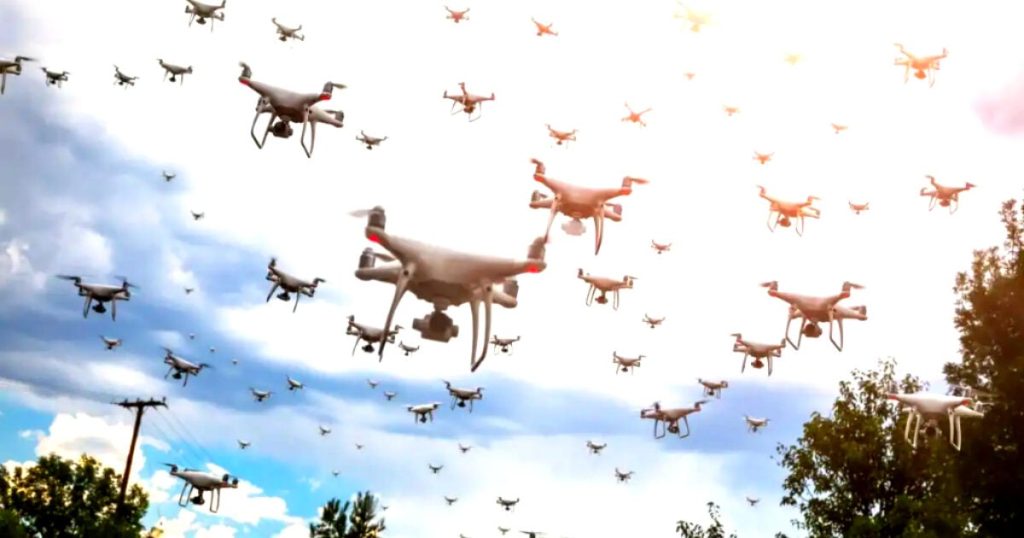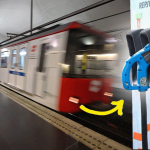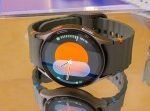It’s a drone world.
All over the world, law-enforcement agencies and military forces are going all-in towards these unmanned flying vehicles that have become the standard equipment to survey and even attack foes and invaders.
From the forests of Eastern Europe to the American Western Mountains of Colorado, all we hear about is d-r-o-n-e-s.
Drones everywhere.
In Europe’s battlefields, drones have long become the ‘ace in the sleeve’ for combatants – from small FPV quadcopters to big deadly craft like the American Predator, Russian Lancet, Iranian Shahed or Turkish Bayraktar drones.
Ukrainian surveillance drone tracks advancing Russian infantry.
Now, as the war in Ukraine progresses, six NATO nations have agreed to build a ‘drone wall’ along their borders to defend themselves against what they see as Russian threats.
Telegraph reported:
“Norway, Poland and Finland will work with the three Baltic states – Estonia, Latvia and Lithuania – to prevent Russian aggression, including forcing migrants across the border.
‘This is a completely new thing. A drone border from Norway to Poland’, Agne Bilotaite, Lithuania’s interior minister, told broadcaster Baltic News Service. ‘This will allow us to protect ourselves from provocations by unfriendly countries’.”
Turkish Bayraktar drone.
These EU countries on the Russian border have become increasingly nervous that an emboldened President Vladimir Putin will turn to them once the war in Ukraine is over.
“In anticipation, Poland has spent billions upgrading its border defenses with Belarus, Estonia has built a network of frontier army bunkers and Finland, which shares an 830-mile border with Russia, has joined Nato.
Last year, Finland was forced to close its border crossings with Russia after the Kremlin flew in migrants from Asia and sent them over the border on bicycles. Finnish officials said Moscow was weaponizing migration to destabilize Europe.”
Russian Geran (Geranium) is based on the Iranian Shahed.
The ‘drone wall’ is still being planned and negotiated, and the deal signed over the weekend is just part of a wider approach to countering ‘the threat from Russia’.
“’We agreed to hold regional drills to ensure the evacuation of the population, to see how our institutions are prepared to work and to interact with each other’, [Lithuanian Minister Bilotaite] said.”
Since the start of the war, Russia has strengthened its military units along the border with EU countries, going as far as to move nuclear missiles to Belarus.
Russian Lancet drones.
Meanwhile, on the other side of the world, local law enforcement agencies in Colorado, including the Denver Police Department (DPD), ‘are making plans to start dispatching drones instead of officers to respond to 911 calls’.
Fox News reported:
“‘This really is the future of law enforcement at some point, whether we like it or not’, Sgt. Jeremiah Gates, who leads the drone unit at the Arapahoe County Sheriff’s Office, told The Denver Post.
At least 20 agencies in Colorado’s Front Range already use drone technology for certain tasks, like searching for missing people, tracking fleeing suspects, mapping crime scenes or overhead surveillance during SWAT operations. Now the sheriff’s office is considering using them to respond to some 911 calls in situations where the drones might be able to provide useful information from the location of an incident before officers are deployed.”
It would also help to weed out calls that do not need police intervention.
“‘I could fly the drone over (a reported suspicious vehicle) and say, ‘Hey, that vehicle is not out of place,’ and I never had to send an officer over to bother them and I can clear it with that’, Gates told The Denver Post. ‘It’s saving resources’.”
American ‘Reaper’ drone.
Of course, you bet there’ll be legal problems with this approach. The Denver Police Depertment shelved its only drone in 2018, citing constitutional concerns.
But now is planning to to expand its drone program using a $100,000 grant from the Denver Police Foundation.
“‘The long-term scope of what we are trying to do is drones as first responders’, Phil Gonshak, director of the department’s Strategic Initiatives Bureau told The Denver Post. ‘Basically, having stations on top of each one of our districts so we can respond with drones to critical needs or emergencies that arise throughout the city’.
‘We would never simply replace calls-for-service response by police officers’, he continued. ‘The DPD would respond to any call for service where someone is physically requesting a police officer on scene. But if there was a fight at Colfax and Cherokee and we put a drone in the air and there is no fight and nothing causing traffic issues, then we would reroute our police officers to other emergent calls’.”
The post DRONES EVERYWHERE: NATO European Nations Plan To Build a ‘Drone Wall’ Against Russia – US State of Colorado To Use UAVs as Police First Responders appeared first on The Gateway Pundit.







